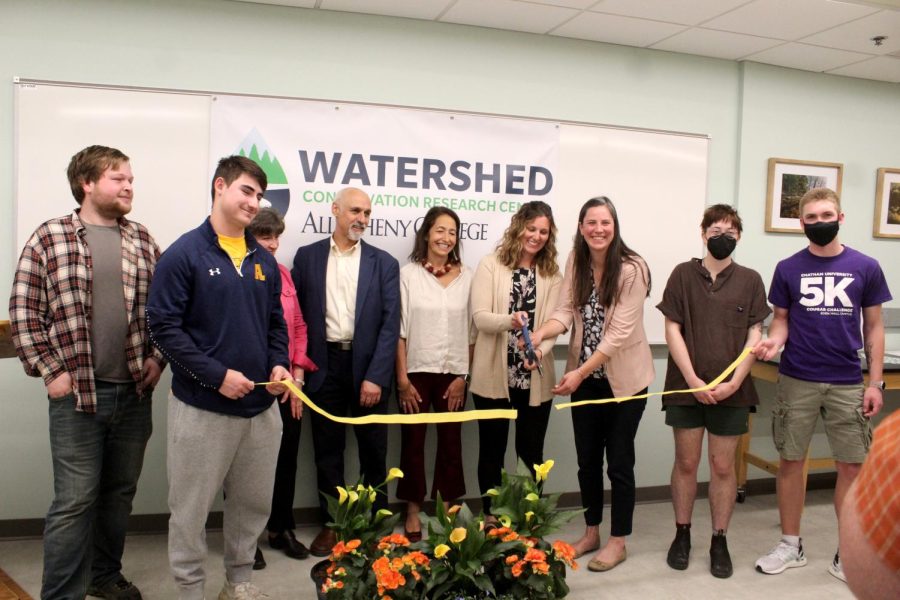Watershed Conservation Research Center preps for inaugural summer
The newly renovated room 101 in the basement of Carr Hall will now be known as the Allegheny College Watershed Conservation Research Center.
First announced in October of last year, the WCRC, as it is known, aims to provide a space for undergraduate research, partnerships with other local conservation organizations and provide educational outreach on the French Creek and its watershed. It officially opened after a ribbon-cutting ceremony on Monday, May 9.
“The WCRC mission is … to engage in strategic conservation activities, and train future watershed stewards, to protect, restore and enhance our land and water resources for future generations in the upper Allegheny River, focusing on the French Creek watershed,” said Assistant Professor of Environmental Science and Sustainability and incoming co-Director of WCRC Casey Bradshaw-Wilson.
Joining Bradshaw-Wilson as co-director is Assistant Professor of Environmental Science and Sustainability Kelly Pearce, who introduced the event and the physical space of the WCRC.
“Previously, this room was designated as an optics lab for the physics department,” Pearce said. “We’re thankful for their willingness to provide us this space, which will help to create a space where research staff, faculty and students (can) work collaboratively on interdisciplinary projects that help us to conserve the upper Allegheny River basin.”
The room itself is the size of a classroom, and will serve as a home base for WCRC’s efforts, Bradshaw-Wilson said.
“We’ll be set up in here to look through microscope systems and get servers prepped for analysis of water chemistry that we send off, those types of things,” Bradshaw-Wilson said. “It’ll be mostly a workstation — a lot of our work is out in the field, so this is just a place for all of our data collection and processing, grant writing, all that type of stuff.”
WCRC is funded by a $1.25 million grant from the Pittsburgh-based Richard King Mellon Foundation, which describes itself as investing, “in the competitive future and quality of life of Southwestern Pennsylvania, and in the protection, preservation and restoration of America’s environmental heritage.”
The Mellon Foundation has a long history of donating to Allegheny College, giving more than $6 million in grants to the college since 1962. In 2016, the Mellon Foundation gave $1.6 million for continued funding of the Allegheny College Creek Connections program and a renovation of Carnegie Hall, and in 2020 provided a $210,000 grant to pay for regular COVID-19 antigen tests provided by the Allegheny College Health Agency.
“(The Mellon Foundation was) very interested in having or starting a research institute similar to ones that they funded in other places, because the French Creek watershed is so important biologically for those living in the area,” Bradshaw-Wilson said. “It made sense to start another center here.”
In addition to funding Allegheny’s WCRC, the Mellon Foundation donated more than $2 million to Susquehanna University in 2014 to establish the school’s Freshwater Research Institute.
“FRI at Susquehanna has a research center similar to ours, although theirs is just focused on what’s in the water, not the whole watershed,” Bradshaw-Wilson said. “We anticipate working closely with them on some shared data between Western Pennsylvania and what’s happening in the center of the state.”
Another key collaborator is the French Creek Valley Conservancy, a non-profit organization that is focused on, “permanent land protection efforts throughout the French Creek Watershed.”
The Conservancy is run by Brenda Costa, ’94, who noted that the WCRC’s research will help guide conservation efforts in the Conservancy’s 3,100 acres of protected land.
“The work here will have a significant impact on the Conservancy’s mission to protect French Creek and the watershed,” Costa said. “(Bradshaw-Wilson) and (Pearce) and I had a meeting a few weeks ago, and we probably came up with a year’s worth of projects that could be done with students and staff to help us in our conservation work.”
In addition to working with other institutes, Bradshaw-Wilson also noted that the program is open to working in other formats.
“While many of our goals are ecologically based, the center is aimed to be interdisciplinary, which is why we have established a mini-grant program through which faculty and students can apply from any discipline or background,” Bradshaw-Wilson said. “For example, an Allegheny faculty member this year, (Assistant Professor of Environmental Science and Sustainability) Jesse Swan-Quinn is working with an Allegheny student to develop a video-based digital exploration of the French Creek watershed, some of its communities, and people’s relationships with the ecosystem.”
Among the disciplines involved in the center will be GIS.
“GIS is an acronym for geographic information systems,” said Chris Shaffer, GIS Manager and Instructor at Allegheny College and head of WCRC’s GIS program. “Basically what we do is we do computer mapping; we take individual maps of different things, maybe like soils, and land cover and distance to roadways and things like that, and we overlay them or layer them on top of each other, and when we do that different patterns and relationships between those data are revealed.”
To further advance GIS projects, WCRC has invested in drones for conducting local research.
“(This summer) we’re gonna do a lot of base mapping of our properties like the Bousson Experimental Forest and Robertson (Athletic Complex), and some of the French Creek Valley Conservancy properties as well,” Shaffer said. “We’ll do flyovers this year, probably go back next year for another flyover and see how the land has changed over those time periods. We’ll be doing a lot of baseline mapping and then supporting any kind of research that’s being done from a geographic standpoint.”
Shaffer invited students interested in working with WCRC’s GIS program to take his introductory GIS course, offered every fall semester.
“That’s a really good introduction to GIS, and it really gives students some exposure to what the technology is,” Shaffer said. “If they’re interested in (GIS), and they want to learn more about work-study opportunities, there are other classes in the department that we use GIS in, the context of the research in those classes.”
Bradshaw-Wilson also encouraged students interested in working with the WCRC to open up conversations with herself and Pearce.
“First and foremost, come talk with (Pearce) and I if you have any interest at all regarding any type of work that we’re doing,” Bradshaw-Wilson said. “If you have any project that’s related (to) our goals and our mission at the WCRC, you can apply with a faculty member and get a mini-grant either during the summer or during the semesters and work on projects.”
Provost and Dean of the College Ron Cole, ’87, hailed the WCRC as a representative of Allegheny’s local sustainability efforts.
“To me the goals of the center, which include experiential and collaborative learning with students, faculty and community partners, epitomize the work that we do at Allegheny with focusing on restoration efforts in the French Creek watershed,” Cole said.

Sami Mirza is a senior from many different places. He is majoring in International Studies with a focus on the Middle East and North Africa and minor in...









